To Antarctica
MCMURDO STATION, ANTARCTICA– I’ve spent the last 4 days in transit from the US to Antarctica. I left home midday on Saturday (22 August), flying from Denver to San Francisco to Auckland, New Zealand to Christchurch, New Zealand, arriving on Monday morning after a bit more than 24 hours of travel. My flight to Antarctica was scheduled for Wednesday morning, so I had a couple of days to spend in Christchurch.
The weather in Christchurch was beautiful, with sunny skies and warm temperatures with highs in the lower 60s F. This was a bit of a surprise since August is still winter in New Zealand. The explanation for the nice weather is that Christchurch was experiencing a weather phenomenon known as a norwester, which is characterized by strong, warm northwesterly winds. This is similar to the warm Chinook winds we get in Colorado or the warm foehn winds of the European Alps. Regardless of the source of the nice weather I took advantage of it by strolling around Christchurch and walking through the city’s beautiful botanic gardens.
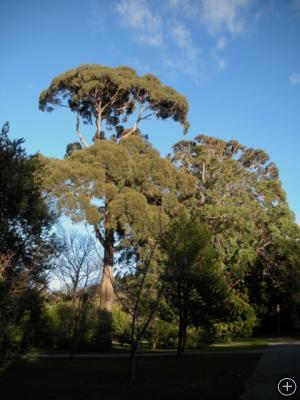
Trees in the Christchurch botanic gardens. Green plants are something I won’t see again until I return to New Zealand in early October.
I also went up to the Port Hills, the remnants of volcanic activity in this region, which provided a beautiful vantage point to watch the sunset over Christchurch, the Canterbury plains, and the Southern Alps.
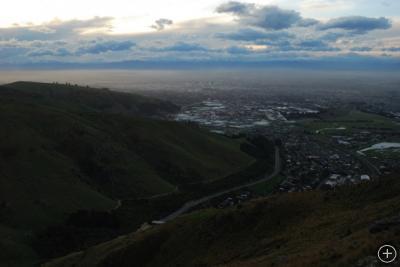
Sunset over Christchurch, the Canterbury plains, and the Southern Alps from the Port Hills just outside of Christchurch.
Of course, my time in Christchurch wasn’t all play – I also went to the United States Antarctic Program (USAP) clothing distribution center (CDC) to get my extreme cold weather (ECW) gear for the trip south. USAP participants are given all of the cold weather gear they’ll need to stay warm and safe while in Antarctica. When trying this gear on in a more temperate location like Christchurch it is easy to think that it is overkill, but I certainly appreciated it when I stepped off of the plane in Antarctica to a temperature of -45 F (although I’m getting slightly ahead of myself).
The flight to Antarctica needs to be timed to coincide with the relatively short daylight hours at this time of year, and so needs to land around noon. This means leaving Christchurch around 7AM, which requires a middle of the night wake-up to get to the CDC, conveniently located next to the Christchurch airport, to get into our cold weather gear and check in for the flight. On the day that we flew to Antarctica (Wednesday 26 August) I got up at 2:30 AM to catch the shuttle to the airport. By 4:30AM I’d changed into my cold weather gear, which included insulated socks and giant white bunny boots, long underwear, pants, and an outer pair of windproof pants, a long underwear top, a fleece jacket, and a giant red parka, glove liners and gloves, a balaclava, fleece hat, and goggles. We boarded the plane, a US Air Force reserve C17 around 6AM and were in the air heading south just before 7AM.
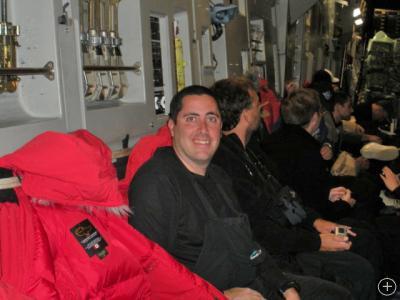
Me on the C17 waiting for take-off from Christchurch. I’ve taken off some of my cold weather gear off for the flight.
There is no mistaking this plane for a commercial aircraft, as the inside looks like the inside of a giant warehouse. A pallet of airline seats is loaded in the cargo area, that provides seating for about half of the passengers, with the remaining passengers sitting on nylon webbing seats that fold down from the walls of the airplane. The airline seats have the advantage of being more comfortable, but with less legroom, while the seats along the walls of the plane are less comfortable, but provide lots of legroom. Given all of the padding from our clothes, I find the less comfortable seats with more legroom to be preferable.
Get the Flash Player to see this player.
Video 1. A view of the inside of the C17 during the flight down to Antarctica. The engine noise you hear on the video is loud enough that it makes talking with other passengers difficult and requires that you use ear plugs for most of the flight.
The flight from Christchurch to the Pegasus ice runway in Antarctica takes about 5 hours. On our final approach the pilot announced that the current weather at Pegasus was -45 F. I’m a bit of a cold weather junky, so hearing this got me excited, as this is the coldest temperature I’ve ever experienced. With temperatures like this it is nice to have all of the ECW gear that seemed like overkill when in Christchurch.

Newly arrived USAP participants waiting to be driven from the Pegasus ice runway to McMurdo Station.
Even though this is my 9th trip to Antarctica it was my first trip that wasn’t during the height of the Antarctic summer (December and January) and I was excited to experience late Antarctic winter, with cold temperatures, strong winds, and dark (during the summer the sun is up 24 hours, so despite having spent many months in the Antarctic previously this was the first time I’d see the sun set and have a dark night). The low sun angle when we got off of the plane cast the familiar landscape of Ross Island, Black and White Islands, and the Transantarctic Mountains in a new light for me.
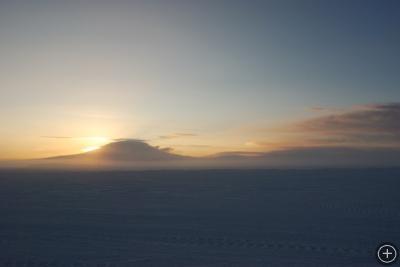
Ross Island from Pegasus ice runway. This photo was taken near noon, yet the sun was low in the sky.
After arriving in McMurdo we went to the mandatory in-brief that gets all new arrivals up to speed on the basics of life in McMurdo. After that we were assigned dorm rooms and picked up our luggage from the flight. The rest of the afternoon was spent getting settled into our lab space in the Crary lab.
By dinnertime it was already dark out, with a glow of orange along the northwest horizon. By the time dinner ended it was completely dark out, and I saw the stars from Antarctica for the first time.
Our first full day in McMurdo (Thursday 27 August) was spent at more meetings and training sessions, as well as getting our lab space setup and all of our gear unpacked. This will continue for the next few days. While we are getting all of our gear setup the last flights to Antarctica, until the end of September, are scheduled to arrive. Once the last flight arrives we will begin setting up our unmanned aerial vehicle (UAV) launch facilities at the Pegasus ice runway. We’re hoping to make our first UAV flight sometime early next week.


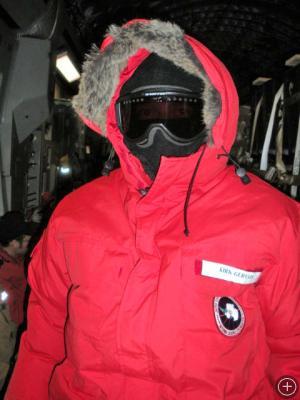
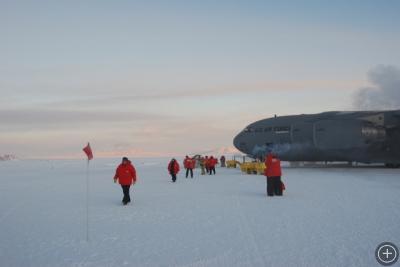



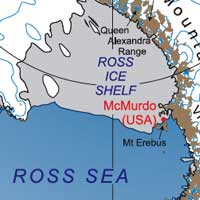





Hi John,
I’m looking forward to following your blog – my brother, Nick, is down there with you and sent us a link to your blog so we could see what he’s up to and look at the pics you post. Sitting here in Melbourne, Australia on a sunny 19 degree celsius day, it’s hard to imagine what -45 is like!!
Wish you all the best with your research,
cheers
Jody
Hi John – we are Nick Logan’s parents and are very interested in the Life & Conditions that you will all be experiencing.
Altho Jody said it was 19 degrees yesterday we have a week of very high winds and rain, but like Jode said its hard to imagine what you are in.
Keep us posted.
Cheers
Bev & Gra
John,
great narrative. wish I could be there with you! Keep up the blog and I will check in regularly to see what your research reveals and new pictures.
thanks,
Have a safe and fun time.
Jeff
John – Polar light, frigid temps, cold weather gear…hearing about the details is great! Will the UAS be able to take off in -45?? Do they ever delay manned flights because of the cold?
Stay warm!
Best,
Adriana
Hi John -
Thanks for posting to this blog – a great way to keep up with how it’s going down there! Hope the UAV ops go well. I’ve had great experiences with Aerosonde in the past – a good group of workers.
Mark
Adriana,
Our plan is to not do any UAV launches if the temperature is below -30 F. We also need relatively light winds as we can’t launch with a crosswind stronger than 8 kts or a headwind stronger than 25 kts.
Some of the manned flights are limited by temperature. At very cold temperature the hydraulic fluids used to control the flaps on the plane become too thick and don’t allow proper operation of the plane. Several years ago the first mid-winter flight to the South Pole was completed to evacuate one of the winter over staff that had become sick and needed surgery. This flight was completed by a Twin Otter aircraft, which can fly at lower temperatures since it does not use hydraulic fluid to control the flaps.
John
Hi John:
Nice to hear that the work is still going at McMurdo and the South Pole station.
Dec 24, 1956 some of us Deep Freeze II guys were playing soft ball on the ice at McMurdo. In 1957 I Wintered over at Cape Hallett with 13 other guys.
Good luck with your work and travels.
Bobby Northcutt CMCS US Navy Retired
Hi John
Spent Cristmas at McMurdo Sound. 1956 We where on our way to build bases at Knox Coast & Cape Hallett.
Our ship USS Arneb AKA 56 was damaged when we met up with an iceburg. I was in the Seabees.
Haven’t been to “the ice”–I have worked with folks that wintered over, though–or on a C-17 cargo plane (I did get rides on C-130s on leave in the Army in Europe long ago–flew from Frankfurt to Athens, then on Olympic Airways to Crete). The C-17 is an improvement to the smaller C-141 they used to use; but has one major drawback it shares with that–apparently it has no windows :-(. It’d be frustrating to miss all that scenery on the way down over the Ross Sea. Take what you’re offered, I guess. The C-130 had a few portholes and I enjoyed a spectacular flight across the Alps from Chateauroux (before the French kicked NATO out) to Athens, and back past Corsica (which I’d visited) on a C-131, the USAF version of the Convair 340 twin. I’ve seen spectacular pictures of the Transantarctic Mts taken from C-130s on the way to the S. Pole.
I wonder if that’s distant Mt. Erebus in one picture.